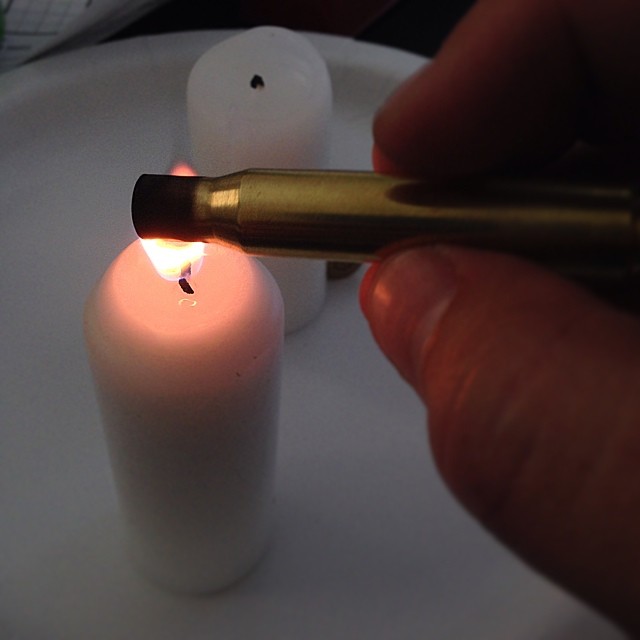Welcome guest, is this your first visit? Create Account now to join.
Welcome to the NZ Hunting and Shooting Forums.
Search Forums
User Tag List
+ Reply to Thread
Results 16 to 30 of 33
Thread: Annealing brass
-
09-01-2022, 05:29 AM #16Member

- Join Date
- Feb 2020
- Location
- Scotland
- Posts
- 1,319
-
-
09-01-2022, 12:37 PM #17
Fred Barker, the man who devised the candle method, discovered that the heat supplied by the candle is sufficient to warm the neck of the pod. The advantage of using a torch is that it does not smoke the neck of the holster and that the desired temperature is reached more quickly. In my opinion, they are not serious drawbacks, the neck of the case is cleaned with the damp cloth, and apart I wash the case before placing the primer.
Last edited by JLF; 09-01-2022 at 12:43 PM.
There is still gunpowder left, the Grim Reaper can wait.
-
09-01-2022, 07:58 PM #18
I have an AMP and have freely annealed brass for a number of forum members. It isn't an essential part of reloading (don't worry too much if you don't anneal!).
It does however do everything @dannyb and others say and can be thought of as one of the extras a reloader can do to lift the quality of their reloads beyond basic sizing, priming, powder charge, and seating. Sorting brass and projectiles by weight, adjusting concentricity of loaded rounds, cleaning the primer pocket, neck turning, cleaning brass before reloading are all in the same category (some of these stop being optional, eg untrimmed brass will FTL or split).
The fundamental rule of reloading is consistency...as little variation as possible from one round to the next to the 100th later. Annealing is one of many actions the reloader can take to eliminate inconsistency. So, not essential but satisfying for the reloader to know that is one less doubt to have when looking at their groups, and their limited supply of brass!
And I am still happy to anneal for free for members per the terms in that thread some time ago
-
17-01-2022, 09:43 AM #19Gone But Not Forgotten

- Join Date
- Feb 2014
- Location
- Taupo
- Posts
- 1,887
-
17-01-2022, 09:49 AM #20Gone But Not Forgotten

- Join Date
- Feb 2014
- Location
- Taupo
- Posts
- 1,887
-
17-01-2022, 01:02 PM #21Member

- Join Date
- Nov 2018
- Location
- Matamata
- Posts
- 2,028
-
17-01-2022, 01:44 PM #22Gone But Not Forgotten

- Join Date
- Feb 2014
- Location
- Taupo
- Posts
- 1,887
-
17-01-2022, 06:42 PM #23Member

- Join Date
- Mar 2012
- Location
- Hastings
- Posts
- 2,893
Some times we forget it is practical reloading not perfect reloading we want. Funny when you hear criticisim of simple methods until you dig deeper to find why the shots are not grouping. Suddenly the the old enemy appears... recoil.LOL.
-
17-01-2022, 07:35 PM #24
Sorry, for most of the shooting I do I strive towards achieving perfect reloading. May not get there but I'm giving it my best.
-
17-02-2022, 02:58 PM #25Member

- Join Date
- Jan 2022
- Location
- clare mi
- Posts
- 13
for my 708 i used a salt annealing method .had it hot around 900F with a 15 count i then resized and used a mandrel 283 and it took about 150 psi to seat bullets . may seem a tad high but thats what the new brass was taking . i sized a brass with out annealing ,took a good deal more psi to seat that bullet
-
17-02-2022, 04:29 PM #26
-
17-02-2022, 08:24 PM #27Member

- Join Date
- Mar 2012
- Location
- Hastings
- Posts
- 2,893
-
17-02-2022, 10:04 PM #28Gone But Not Forgotten

- Join Date
- Feb 2014
- Location
- Taupo
- Posts
- 1,887
I used the drill method for years and frankly didn't get any real advantage. Consistency is where it's at and that's very hard to achieve. Enter the AMP Mk II (stands for annealing made perfect) which uses software that analyses a sacrificial case and gives you a number to use for that particular brass. You record that number and use it whenever you anneal that batch of brass again. I realise it's a machine that a lot of people can't afford. Pretty impressive though and well worth it if you want perfectly consistent annealing which in turn gives the foundation for consistent neck tension.
-
17-02-2022, 10:53 PM #29
-
31-03-2022, 03:39 PM #30Member

- Join Date
- Jan 2022
- Location
- clare mi
- Posts
- 13
Similar Threads
-
What's everyone using to de cap brass without sizing for annealing ?
By dannyb in forum Reloading and BallisticsReplies: 36Last Post: 27-12-2019, 07:18 AM -
Brass Annealing
By 25 /08 IMP in forum Projects and Home BuildsReplies: 6Last Post: 22-07-2019, 11:04 AM -
Annealing brass - too hot?
By chainsaw in forum Reloading and BallisticsReplies: 19Last Post: 07-11-2017, 12:47 PM -
Annealing Privi and S&B brass
By Frogfeatures in forum Reloading and BallisticsReplies: 2Last Post: 20-02-2016, 10:02 PM
Tags for this Thread
Welcome to NZ Hunting and Shooting Forums! We see you're new here, or arn't logged in. Create an account, and Login for full access including our FREE BUY and SELL section Register NOW!!





 42Likes
42Likes LinkBack URL
LinkBack URL About LinkBacks
About LinkBacks





 Reply With Quote
Reply With Quote





Bookmarks